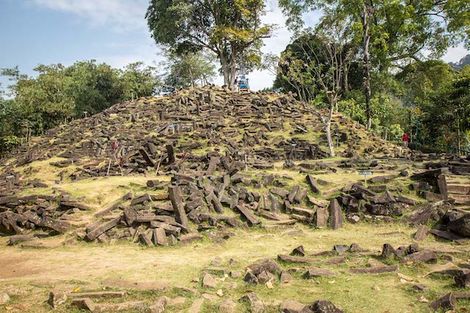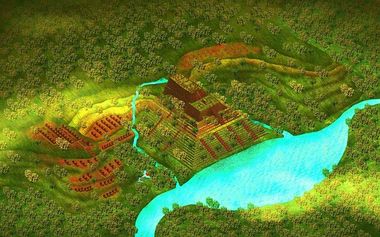Mount Padang: Difference between revisions
No edit summary |
|||
| Line 15: | Line 15: | ||
[[File:GPR.jpg|380px|thumb|right|Archaeologists propose that there is more beneath the surface than what we know. They also believe this is what Mount Padang looked like thousands of years ago.]] | [[File:GPR.jpg|380px|thumb|right|Archaeologists propose that there is more beneath the surface than what we know. They also believe this is what Mount Padang looked like thousands of years ago.]] | ||
The mountain is | The mountain was originally a volcano, with a chamber of lava, or magma beneath its surface. Geologists and other scientists have dated the mountain to be from the Tertiary period, which puts its age somewhere between 66 million to 2.6 million years ago. This time frame is quite large, and assigning an "age" to something not alive is not entirely necessary for just a mountain that is no longer a volcano. However, it is important to know a relative date in terms of figuring out this megalithic site in an archaeological context. This will at least tell us who was around/alive and could have potentially interacted with the mountain. There are multiple layers that compose the entirety of the mountain, each with varying depths. Of the four layers that exist, the fourth one sits at the bottom, and is also the deepest. The fourth layer is about 15 to 20 meters think, and is the remnants of the volcano that existed prior. It is composed of andesitic basalt rocks and has not been modified by humans. Beneath the fourth layer is a void, or a tube, that scientists do not know much about. The second and third layer have about the same depths, but have been modified by humans. It is | ||
== Discovery == | == Discovery == | ||
Revision as of 22:53, 21 November 2019
What Is It?

Mount Padang, which is sometimes also referred to as Gunung Padang, is a 300 foot step pyramid that is located in a small village called Karyamukti, on the island of Java. The island of Java is split up into five separate provinces: East, Central, and West Java, as well as Banten, and the Special Region of Yogyakarta. Mount Padang resides in the province of West Java. The name "Mount Padang" roughly translates to Mountain of Light, or Mountain of Enlightenment.[1] Because the top of the mountain is covered in large stone slabs, that makes Mount Padang a megalithic site. The site of Mount Padang is known to be the largest megalithic site known to man in all of South East Asia.[2] Megalithic sites are sites that are constructed using large stones to make monuments, typically for religious reasons, and sometimes for political leaders of a civilization. What sits at the top of the mount is what most people know Mount Padang for, which is largely still a mystery to archaeologists of today. The mountain is covered in grass, trees, and many other forms of vegetation, and with a large spiral of stones sitting on the top. In its known history, the area was used as a place for relaxation and meditation.[1] Those who live around the mountain have always known that to be the case, and that its purpose was only for relaxation. Mount Padang's use is not overly known, which has lead pseudo-archaeologists to try and answer that question for us. The site has been excavated once over the year of 2014, and several surveys have been conducted that tell archaeologists, and even geologists what lie beneath the surface.
What Does it Look Like?

The whole mountain is separated into five terraces. It resembles a Step Pyramid like that of Djoser's in Saqqara, except it is coveredin vegetation. The construction on each of them is relatively the same, which suggests that one culture constructed the whole megalithic site. Some people believe that this site was actually a combination of a few different civilizations. Each terrace is connected by a stone stairway, with pillars all the way to the top. From bottom to top, there is a total of 370 steps, which puts the top of Mount Padang at an elevation of 960 meters above sea level.[3] All five terraces are placed relatively in front of each other so they are somewhat level with one another. All of the stones and pillars look to be elaborately placed, with some forming room like structures and entrances. Aerial imaging shows this clearly, that perhaps at some point this was a mountain covered in rooms. There is no evidence that suggests there were ever roofs though, which leads to the theory of open air sanctuary or place of worship.
Geological Formation

The mountain was originally a volcano, with a chamber of lava, or magma beneath its surface. Geologists and other scientists have dated the mountain to be from the Tertiary period, which puts its age somewhere between 66 million to 2.6 million years ago. This time frame is quite large, and assigning an "age" to something not alive is not entirely necessary for just a mountain that is no longer a volcano. However, it is important to know a relative date in terms of figuring out this megalithic site in an archaeological context. This will at least tell us who was around/alive and could have potentially interacted with the mountain. There are multiple layers that compose the entirety of the mountain, each with varying depths. Of the four layers that exist, the fourth one sits at the bottom, and is also the deepest. The fourth layer is about 15 to 20 meters think, and is the remnants of the volcano that existed prior. It is composed of andesitic basalt rocks and has not been modified by humans. Beneath the fourth layer is a void, or a tube, that scientists do not know much about. The second and third layer have about the same depths, but have been modified by humans. It is
Discovery
Originally discovered in 1914 by Dutch colonists. It first appeared in publications from a man named Rapporten van de Oudheidkundige Dienst, in the "Report of the Department of Antiquities."[3] It was then mentioned again in 1949 in a work by a Dutch Historian, N. J. Krom.[3] The Dutch have had a long standing colonization of Indonesia, and more specifically the island of Java, where Mount Padang sits. The Dutch were interested in colonizing this island after the collapse of the Dutch East Indies, so as to set up a new and successful administration here. Java was the main focus for the Dutch, as it was determined the other islands of Indonesia would not profit the Dutch like Java would. This area endured many years of war between those who wanted to take control of the land, and those who were indigenous to the island of Java. Because of the Spice Route and the spices found within the islands of Java, the Dutch were obviously very interested in obtaining the control of this area.[4] It was not until 1979 that archaeologists finally "discovered" it for themselves. At this time, the National Archeology Research Centre began to start observing this site and being
Pseudo Deconstruction of Mount Padang
- ↑ 1.0 1.1 https://www.sott.net/article/271881-Gunung-Padang-The-lost-records-of-Atlantis
- ↑ https://www.globalindonesianvoices.com/17286/megalithic-sites-in-indonesia/
- ↑ 3.0 3.1 3.2 http://www.andrewcollins.com/page/articles/gp.htm
- ↑ https://theindoproject.org/a-brief-history-of-the-dutch-east-indies-part-1/